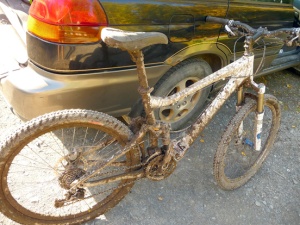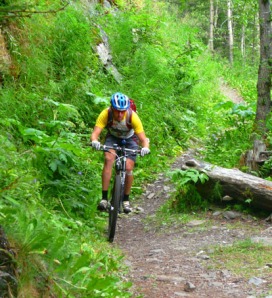By Dante Petri, for the Redoubt Reporter
I hate the summer-to-winter transition from the quick-and-easy lubing up of a chain and airing up of tires on a bike before heading out for a ride, compared to the much more laborious task of waxing, prior to skiing.
This past winter was the first year I ever had what I might call a “ski mechanical.” Ultimately, this amounted to a busted boot and, a few days later, a busted binding, on a set of hardworking skate skis that were halfway into their fourth season and should have been retired a season and a half prior. They were well-traveled and worn down, and I made the wise and rewarding choice of replacing them with a new set of skis. I couldn’t have been happier with them. End of story.
If I did the same thing every time I had a significant mechanical on one of my mountain bikes, well, I’d probably have to get at least a couple new bikes a season.
 |
Mud, rocks and roots all help grind down the parts of mountain bikes and make mechanicals inevitable.
|
As it is, I use the term “mountain bike” in the plural, as, like other cyclists who rack up lots of mileage on and off road, I have more than one bike to help spread out the abuse.
Even so, when I lived back East where the riding season was a good two months longer, I usually got off the bikes — all of them — for about two weeks in mid- to late July.
The R and R was for both for me and the two-wheeled beasts. It helped that this time of year was usually hot and muggy, punctuated by randomly passing thunderstorms that turned trails into swamps in only minutes. It also helped that my interest in bikes had usually passed its peak, and backpacking and swimming in cool rivers seemed much more appealing.
But even more, it helped that bikes are really just assemblages of numerous small machines, linked together, all waiting to fail at some point. And often, that was right about mid-July.
In the North, the riding season is compressed, and like other summer activities up here, I feel obligated to cram in as much warm-weather riding as possible.
I try to prepare for this by doing preventative maintenance at season’s end: bringing my rigs into shops for professional tuneups, sending parts back to the factories for rebuilds, and getting everything ready for the first days of spring. The end goal — have as little downtime as possible through the following summer.
 |
Magic carpet ride or ticking time bomb? With mountain bikes, they’re one in the same. Even a sunny ride can go south fast thanks to a rotten stick, jagged rock or a worn-out component.
|
I should have been forewarned of the impending disaster, as one of my Kenai Peninsula riding buddies, Adam Reimer, was afflicted first.
When the meltdown hits, it comes like a summer downpour, and often with little to no warning — in a mere 14 miles of one ride he managed to tweak his rear derailleur with a rotten twig, break a pedal and finally split the sidewall of his rear tire before finally admitting defeat and limping back to the car on the road. The sting was made only worse by the bright sun overhead, the dry trail conditions we knew would not last into the fall, and high expectations for a strong ride.
A week later we were back at it again, attacking the very same trail. This time, Adam came armed with a second bike just in case, yet only six or seven miles into this ride, as luck would have it, a sharp rock bit off a chunk of his rear tire and again his situation looked bleak.
For a moment, I thought Adam’s bike was going to become a permanent fixture in that ancient forest, wrapped around one of the giant, lichen-covered spruce trees. Further examination of the tire revealed we could patch the hole and finish the ride, even though we accepted a bit of risk in doing so.
My bike juju had just begun, though. We arrived back at the car, feeling victorious for a few minutes, before I noticed my fork had begun profusely leaking oil on the long descent. Ca-ching. A few days earlier I’d broken the shifter on my other mountain bike in the middle of a race. Ca-ching. Guess what? A few days later I broke a shifter clean off my road bike. Ca … are you getting the picture?
In a single week I went from three functional bikes to none.
I’d found my midseason slump, or, at least the mechanical version of it.
It was somewhat amusing for me, though, to compare how Adam and I reacted to our mechanical follies.
Adam, who is not only both more aged and wiser than I, but also a far superior athlete with a long history of competing on road bikes, has a bit less experience when it comes to the modern mountain bike.
I could really sympathize with him and his frustration when it looked like he was going to get the shaft two weekends in a row, though, even if I chuckled a little, because I knew the feeling, really well.
The problem with this sport is that we demand perfection from every ride. Sometimes, even when the sky is blue, if I don’t get to hammer as hard as I want to for whatever reason — trail conditions, bike problems, human problems or some combination of the above — the ride feels like a loss.
When you add in a week of being cooped up at work eagerly anticipating the weekend, only to have it not quite pan out, I’ve sometimes stood on the trail and felt like the very basis of my love for the sport was hissing out of me like air from a blown tire, 10 miles from anywhere.
“I should just take up running, or hiking, or going to the gym!” I think, sometimes out loud if I’m getting close to hysterics. “There’s no taco’d rims, blown-out hubs or shifty shifting in those sports.”
Many a time I admit I’ve come close to sending my bike airborne, lest a rider, out of frustration from what felt like an unending slew of breakdowns.
There comes a point in every bike’s life cycle where that’s probably not such a bad idea, but knowing where that point is, and accepting the breakdown for what it is, is as much a part of mountain biking as roots, rocks and mud.
When I snapped off my road bike’s shifter, I’m sure the look on my face was amazing, but after the realization hit that, yes, I no longer had a single functioning bike, I just sat back, shoved the shifter into my jersey pocket and smiled.
I knew exactly what I would not be doing for another week or so.

No comments:
Post a Comment